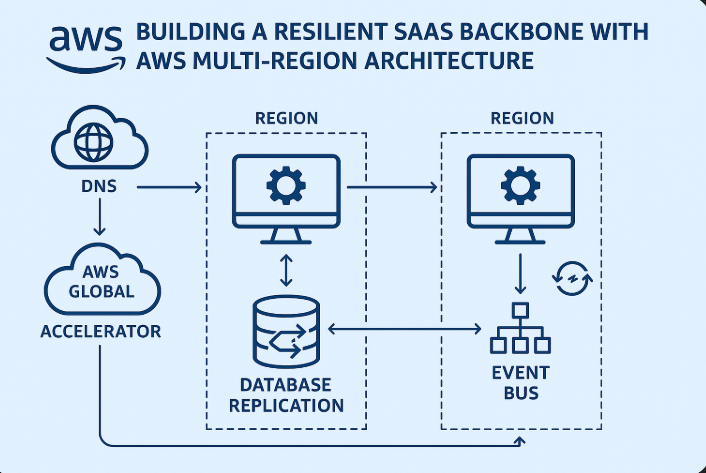
In today’s global digital landscape, downtime is not an option. For SaaS providers, especially those serving users across continents, application resilience and availability are not just technical preferences—they’re business imperatives.
A single-region AWS deployment can’t meet the availability demands of a global SaaS product. Network latency, regional outages, and regulatory requirements necessitate a multi-region architecture. In this guide, we’ll explore how to build a resilient SaaS backbone using AWS’s multi-region capabilities.
Why Multi-Region Architecture for SaaS?
1. High Availability (HA)
If a region becomes unavailable due to a service disruption or natural disaster, traffic can be rerouted to another region with minimal impact.
2. Disaster Recovery (DR)
Multi-region replication of data and services ensures rapid recovery and business continuity in failure scenarios.
3. Low Latency Global Access
Users in Asia, North America, and Europe can be served from the closest AWS region, dramatically reducing latency.
4. Regulatory Compliance
Some regions, such as the EU, require that user data stay within specific jurisdictions.
Key Components of a Resilient Multi-Region SaaS Architecture
1. Global DNS with Amazon Route 53
Use Route 53 latency-based routing or geolocation routing to direct users to the nearest regional backend.
Health checks ensure that traffic is automatically redirected in the event of a regional outage.
Supports active-active and active-passive configurations.
2. Global Load Balancing with AWS Global Accelerator
Global Accelerator provides static anycast IPs that route traffic over AWS’s global network to the optimal region.
Improves availability and performance
Automatic failover to healthy endpoints in different regions
3. Multi-Region Application Layer
Deploy stateless services (e.g., microservices in ECS, EKS, or Lambda) in multiple regions.
Use CI/CD pipelines (CodePipeline, CodeDeploy) to ensure consistent deployment
Separate config via AWS Systems Manager Parameter Store or Secrets Manager
4. Cross-Region Data Replication
Databases: Use Amazon RDS Global Databases or Aurora Global Databases for read replicas across regions with fast failover.
Storage: Replicate S3 buckets using Cross-Region Replication (CRR).
Caching: Leverage Amazon ElastiCache Global Datastore for Redis for low-latency access.
5. Asynchronous Communication and Event Handling
Use Amazon SNS + SQS for decoupled event-driven architecture
Use EventBridge across regions with custom buses for asynchronous workflows
Deployment Models: Active-Active vs Active-Passive
| Model | Description | Pros | Cons |
|---|---|---|---|
| Active-Active | All regions serve traffic simultaneously | Lower latency, load distributed | Complex data sync and consistency |
| Active-Passive | Primary serves all traffic, secondary on standby | Easier to manage state and cost-efficient | Higher failover latency |
Choose based on business needs, budget, and data consistency requirements.
Best Practices for Multi-Region SaaS Architecture
Infrastructure as Code (IaC): Use CloudFormation or Terraform to manage region-specific stacks.
Monitoring and Observability: Use CloudWatch, X-Ray, and centralized logging with Amazon OpenSearch.
Security Controls: Enforce IAM policies and encryption across all regions.
Regular DR Drills: Simulate region failovers using AWS Fault Injection Simulator.
Cost Visibility: Tag resources by region and service for accurate cost tracking.
CloudFlew: Helping SaaS Teams Go Global with Confidence
At CloudFlew, we specialize in designing and deploying resilient, scalable multi-region AWS infrastructures for SaaS providers. Our services include:
Multi-region architecture blueprint and consulting
Automated CI/CD pipelines for global rollouts
RDS/Aurora cross-region replication setup
Chaos engineering and DR testing support
Security hardening and compliance enforcement
In the era of always-on, global-first applications, resilience isn’t a bonus—it’s the foundation. With AWS’s multi-region capabilities and the right architectural approach, your SaaS product can deliver consistent performance and availability to users around the world.
Let CloudFlew help you build it right.

